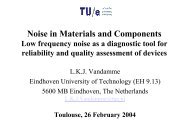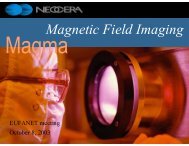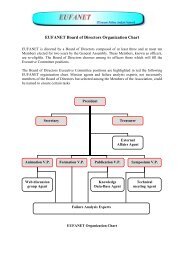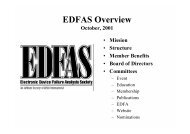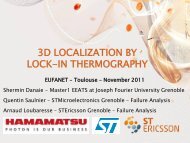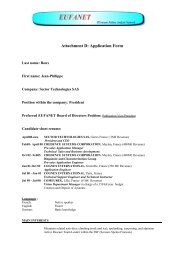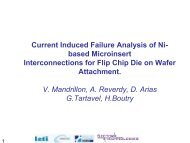Application of transient interferometric mapping
Application of transient interferometric mapping
Application of transient interferometric mapping
- No tags were found...
Create successful ePaper yourself
Turn your PDF publications into a flip-book with our unique Google optimized e-Paper software.
Outline• Motivation• Principle <strong>of</strong> Transient Interferometric Mapping (TIM)• <strong>Application</strong> example <strong>of</strong> TIM– Thermal breakdown mechanism in ESD protection devicesdue current filaments– Analysis <strong>of</strong> carrier plasma spreading in 90nm CMOS SCRESD protection device– Transient latch-up analysis in 90nm CMOS test chip– Failure analysis• Conclusions
MotivationExperimental access to internal device parameters (temperature,carrier concentration, current density, electric field) is important for: Finding critical places in devices - hot spots, thermo-mechanicalstress,..Device structure and performance optimization Verification <strong>of</strong> simulation results Calibration <strong>of</strong> simulation models Prediction <strong>of</strong> device failure thresholdThermal and high injection effects important in: power devices,electrostatic discharge (ESD) protection devices, etc...⇒ TIM method provides µm space and ns time resolutionand access to bulk properties from backside
Electrostatic discharge (ESD)Human Body Model (HBM)RelayswitchR=1.5kΩL1-10kVHVC=100pFDUT1-5Amps@100nsCatastrophic failure[Amerasekera & Duvvury, 1995]- ESD more and more important withscaling down technologies- higher power dissipation densities insmaller volumes higher temperaturesup to silicon melting point[Courtesy W. Stadler, Infineon]
Backside Transient Interferometric Mapping (TIM)IR laser, wavelength=1.3µm is transparent for SiΔϕdrainmicroscope objectivegateheatingsubstratePolishedchipbackside* Temperatureand carrier conc.variations⇓* Change inrefractive index⇓* Optical phaseshift Δϕ⇓* Interferometricdetection
General optical principle <strong>of</strong> TIMOptical phase shift (integral along the laser path):Δϕ4πλ() t = ΔT( z, t) + α Δn( z, t) + α Δp( z, t)∫⎧ dn⎨⎩dT[ ]np⎭ ⎬⎫ dzThermal contribution>0+Free-carrier contribution
Method is quantitative:APEX postprocessor <strong>of</strong> Synopsis allows calculation <strong>of</strong>phase shift data from the simulated temperature and freecarrier distributions <strong>of</strong> device simulation (TCAD) DESSIS
Transient <strong>interferometric</strong> <strong>mapping</strong> (TIM) at TUVienna:* Scanning heterodyne interferometer + Michelson- 3ns and 1.5µm resolution- phase shift <strong>transient</strong>s recorded at eachscanning position- repetitive stressing necessary forspatial imaging* 2D holographic <strong>interferometric</strong> method- 5ns and 3µm resolution- one or two 2D images recordedper single stress pulse- single event thermal imaging- wafer level probing possible
Scanning heterodyne interferometerlaser diodeλ=1310 nmω 1ω 2+microscopeobjectivexy-stage* 1.5µm space resolution* 3ns time resolutionAOMmirrorD.U.T.photodiodeexternalreferencemirrorIR observationcameraTLP testervf-TLP testerDMOS pulserMOS-switchSpatialdistribution:- periodicaldevice stressing- lateral devicescanningHVsourceFocused laser beam used Fürböck &, Microel. Rel. 40(2000)1365]
Scanning heterodyne interferometer: signal and phase shiftDetector signalPhase shift (rad)1.61.20.80.40.0ΔϕHeatingheatingnoheating0 200 400 600 800Time (ns)Detector signal:A sin[2Δωt+Δϕ(t)]* Time domain detection* Automated acquisition* FFT analysis* phase extractioninsensitive to samplereflectivity[Fürböck &, J. Elstat, 49(2000)195][M.Litzenberger &, IEEE TIM, 54(2005)2438]
2D TIM method: Phase extractionInterferogram:Unstressed Stressed[D.Pogany &, IEEE EDL, 23(2002)606]p-bodyAnodep+ n+n+ buried layern-epip-substrate⊕n+ sinkerCathodePhase extractionbased on FFT analysisTemperature-inducedphase shiftPhase(Stressed) - Phase(Unstressed)⇒
2D TIM methodImaging at two time instants during a single shotIRcamera 2IRcamera 1MonitorPCPulsecontrolDUTMOMLPBS L NPBSDETLaser 2 PBSLaser 1CT1 1kΩ50ΩOSCIL.Beam 1HVelectron.pulserBeam 2Electricalsignal path• orthogonally polarizedlaser beams• laser pulse duration5ns• relative laser pulsedelay 0 ns - 5 μs• phase distribution attwo time instantsduring single stresspulse- non-repetitivephenomena(destructive)[Dubec &, Microel.Reliab.44(2004)1793]
Model verification at high temperatures by TIMESD protection diode : comparisom TIM vs. TCAD simulationUp to 1100K models for impact ion. coeff. verified experimentally[S. Reggiani et al. I3E EDL, vol.26 2005, p.916]
Current filament dynamics in ESD protection devicesPhase shift –measuredAnode⊕p+ n+n-epip-bodyn+ buried layerp-substraten+ sinkerCathodeP2D – extractedpower density130 nsFilament hasbeen created130 ns200 nsFilamentmoves to left200 ns290 nsFilamentreflects fromdevice corner290 ns530 nsFilamentmoves back530 ns-1 rad4 rad-3030 mW/μm 2[Dubec &, Microel.Reliab. 44(2004)1793]
Instantaneouspower extractionfrom TIMmeasurementsFilament movement alongthe device widthNpn ESD prot. deviceanodecathode+Device lengthDevice widthCalculated:P 2D ≈curr.densityp+ n+p bodyIavlaser beamn- epin+sinkern+ buried layerDevice widthp - substrateMeasured:Δϕ:memoryeffectDevice lengthBy 2D scanning[Pogany &, App.Phys.Lett,81(2002)2881]
Second breakdown due to stopped current filaments10.90.8w200, 600-620 nsw200, 70-90 nsTLP Current (A)0.70.60.50.40.30.20.100 10 20 30 40 50 60TLP Voltage (V)p-bodyAnodep+ n+n+ buried layern-epip-substrate⊕n+ sinkerCathodeVoltage (V)252015105t TBOptimized structures00 200 400 600 800 1000time (ns)Thermal breakdown (TB) occurs when filament reaches an alreadypreheated region (edge, or start position) improving t TB[D. Johnsson &, IRPS08, p.240]
TLU analysis in 90nm CMOS structures* Invertor sensitivity toLatch –up is studued* Injector diode emulatessubstrate current injectionDetector Voltage3V0V0µs 1µs 2µs 3µsPhase [mrad]0-500µs 1µs 2µs 3µsLaser[K.Domanski et al. EOS/ESD’07, p.347]
Carrier an heat distribution during TLU event:effect <strong>of</strong> guard rings studiedGuardRingfloating:GuardRing3V:[K.Domanski et al.EOS/ESD’07, p.347]-200mApulse <strong>of</strong>1623ns• Carrier diffusion length can be experimentally determinedTU-Wien ≈100µm (≈1µs) → calibration <strong>of</strong> simulator• Guard ring effect demonstrated –still carrent via substrate
90 nm CMOS SCR study: spreading <strong>of</strong> the on statet1t2 >t1P-well, P-substrateN-welln+p+n+YZp+t3 >t2n+p+-electron-hole plasma spreads with timeto sides and to substrate- heating follows with a delay the currentflowDensity <strong>of</strong> current inside filamentt1: t2: t3:J1 J2
ESD failure detection using 2D TIM method– rough position detection in a large field <strong>of</strong> view2 mW ~ 3 mrad FOV1.6x1.3 mmIR imageInterferogram difference2 mW ~ 3 mradStroboscopicdetection usingrepetitivepulses +stabizedMichelsoninterferometerIR imageTesting on npn transistorInterferogram differenceFOV3x2.5 mm[V.Dubec et al. , Microel. Reliab, 47(2007)1549]
Scanning TIM technique for failure analysis- metal short detection[V.Dubec et al. , Microel. Reliab, 47(2007)1549]2D scanLaserω ω+Ω 1ω+Ω 2DETAOM+L.O.Microscope= PhaseDUTScan area1x1 mm(metal short)Ω 1t - Ω 2t + Δϕ Ω 1t - Ω 2t Δϕ• power resolution up to 50 μW• spatial resolution 2 μm• comparable to standard FA methods(e.g. TIVA)•possible to combine FA with standardTIM for ESD analysisSingle beam scan0.4Differential scanPhase (rad)0.30.20.10.0IR image-800 -600 -400 -200 0 200X-position (μm)
ConclusionsTIM :– free carrier and thermal dynamics can be detected with ns timeand µm space resolution– understanding device physics and for device layout optimisation- used for calibration and verification <strong>of</strong> device simulation modelsunder high current and high temperature conditions- failure analysis application- other applications include thermal <strong>mapping</strong> <strong>of</strong> GaN HEMTs,lasers [J.Kuzmik &, APL 2003, IEEE TED 2005, SSE 2006,…]






